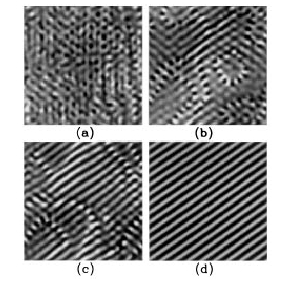|
Nonlinear Dynamics and Complexity in
Optical Physics:
Chaos
and Control in Lasers and Nonlinear Devices
Chaos is an inherent feature of many nonlinear systems. In particular, the transition from order
to disorder occurs with universality, irrespective of physical properties
of the systems. Chaos occurs in
optics, both in lasers and in nonlinear optical devices. Such systems, which are fundamentally
simple both in construction and in the mathematics that describe them,
provide excellent opportunities for investigating these nonlinear phenomena
as well as for technological innovation.
Our experimental and theoretical work addresses chaos and control of
chaos. Through the new perspectives
of nonlinear dynamical theory these programmes explore the universality of
such behaviour, its physical origins and the bearing it has on conventional
understanding of nonlinear optical interaction phenomena. Among these are nonlinear mixing and
coupling, phase conjugation and nonlinear beam propagation. The systems researched include
solid-state lasers, gas lasers, optical fibres and optical devices such as
nonlinear switching systems and phase conjugations. Recent contributors have led to the
discoveries of instabilities and chaos in beam propagation in optical fibre
through stimulated scattering and nonlinear refraction and classifiable
routes to chaos in solid state and gas laser systems.

Figure: Time evolution of
transverse field distribution of a laser showing turbulent emission (a) and
its evolution (b) and (c) to a striped pattern (d) when feedback control is
applied [Lu et al, Phys. Rev. Lett. 76(18), 3316-3319 (1996)].
Most recently, attention has been focussed on chaos and control of
chaos in semiconductor diode laser and laser arrays, the latter offering
unique opportunities for applications in optical signal processing, secure
communication and for the exploitation of giant coherent laser sources.
The group's research activity in the field of nonlinear dynamics and
chaos in optics is a forefronting effort in the UK and is well respected
internationally for its many contributions which span some 15 years. Continuously supported by funding from
the EPSRC, the programmes involves active collaborations in Europe through
a former EC twinning of twenty participating universities and institutes
and in the USA with Phillips Lab, NM, through AFOSR.
Research
areas:
·
Nonlinear dynamics
and temporal chaos in low dimensional optical systems
·
Control of chaos in
single element lasers and optical devices
·
Secure
communications through synchronized chaos for optical transmission
·
Optical Processes:
o
Lasing
o
Stimulated
scattering and wave mixing
o
Phase conjugation
o
Nonlinear
absorption and refraction
·
Systems:
o
Optical fibres
o
Semiconductor
lasers
o
Optical bistable
and logic switches
o
Solid state and gas
lasers
Back to Research Reviews'
Page
|